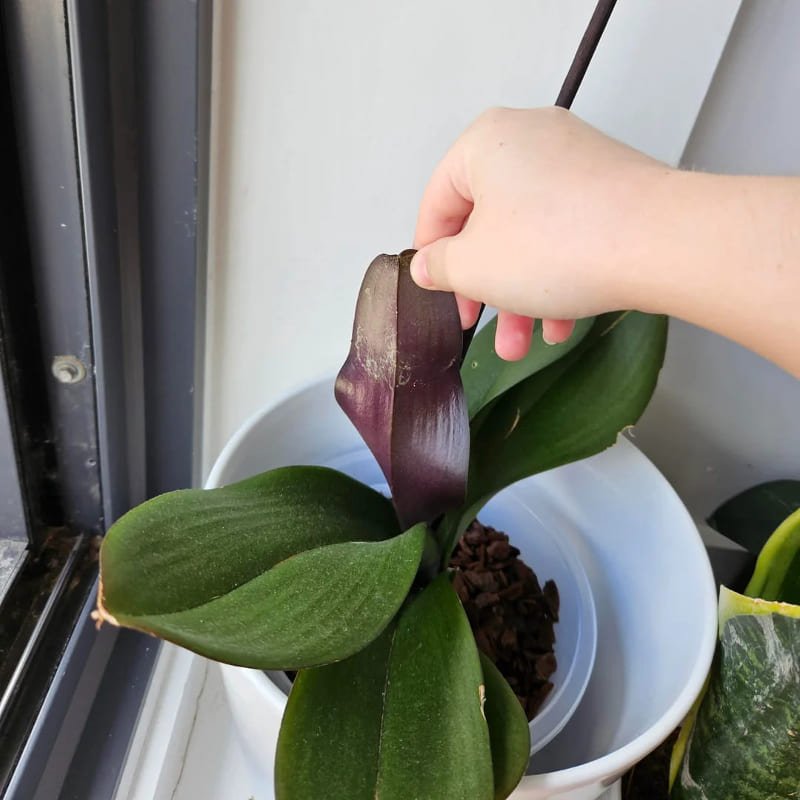There’s something enchanting about orchids. Their delicate blooms seem to defy gravity, offering an air of elegance that makes them one of the most beloved houseplants. But what happens when your orchid’s vibrant green leaves start turning purple? If you’re staring at your plant in confusion—or maybe even panic—you’re not alone. This transformation might feel like a warning sign, but let’s take a deep breath and explore what’s really happening.
In this guide, we’ll walk you through the potential causes of purple orchid leaves and, more importantly, what you can do about it. If you are someone who has spent years nurturing orchids (and making plenty of mistakes along the way), we understand the frustration and helplessness that can come with plant problems.
But trust us, every purple leaf tells a story—and we’re here to help you decode it.
When Your Orchids Go From Green to Purple

Before diving into the causes of purple leaves, it’s essential to understand what’s normal for orchids. Healthy orchid leaves are typically a vibrant green. They serve as the plant’s “powerhouse,” absorbing sunlight for photosynthesis. Changes in color—whether it’s yellowing, browning, or purpling—indicate that your orchid is responding to its environment. Think of it as the plant’s way of waving a tiny flag to get your attention.
1. The Role of Anthocyanins: Nature’s Sunscreen
One of the most common reasons orchid leaves turn purple is the production of anthocyanins. These are natural pigments that act as a sunscreen for plants. When your orchid is exposed to bright or direct sunlight, it may produce anthocyanins to protect itself from UV damage. While it’s a fascinating survival mechanism, it’s also a sign that your orchid might be getting more light than it needs.
What to Do:
- Adjust Lighting: Move your orchid to a spot with bright but indirect sunlight. East-facing windows are often ideal.
- Use Sheer Curtains: If your orchid is near a south- or west-facing window, a sheer curtain can diffuse harsh rays.
Don’t feel guilty about this—it’s a common misstep! Orchids thrive on balance, and finding the right light is part of the learning curve.
2. Temperature Stress: Orchids Don’t Like Extremes
Another culprit behind purple leaves is temperature stress. Orchids are tropical plants, so they prefer consistent, moderate temperatures. If your orchid is exposed to sudden drops in temperature—for example, near a drafty window in winter—it might respond by turning its leaves purple.
What to Do:
- Monitor Temperature: Keep your orchid in a space where the temperature ranges between 60°F and 80°F (15°C to 27°C).
- Avoid Drafts: Move your orchid away from windows, doors, or vents that might expose it to cold air.
Remember, orchids are like Goldilocks—they want conditions that are “just right.”
3. Nutrient Deficiencies: A Silent Struggle
Purple leaves can sometimes indicate a lack of essential nutrients, particularly phosphorus. Phosphorus is crucial for energy transfer within the plant, and a deficiency can manifest as discoloration. If your orchid isn’t getting the right balance of nutrients, it’s essentially running on empty.
What to Do:
- Fertilize Regularly: Use a balanced orchid fertilizer (20-20-20) or one specially formulated for blooming orchids. Follow the “weakly, weekly” rule: dilute the fertilizer to half strength and apply it weekly.
- Flush Salt Build-Up: Over time, salts from fertilizers can accumulate in the potting medium. Flush your orchid’s roots with distilled water once a month to prevent this.
It’s easy to overlook feeding schedules, but orchids are forgiving plants. With a little care, they bounce back beautifully.
4. Root Health: The Hidden Connection
Healthy roots are the foundation of a thriving orchid. If the roots are struggling—due to overwatering, underwatering, or root rot—the leaves may turn purple as a distress signal. Orchids need a delicate balance of moisture and airflow to keep their roots happy.
What to Do:
- Check the Roots: Gently lift your orchid from its pot. Healthy roots are firm and white or green. Brown, mushy roots indicate rot.
- Repot If Necessary: If the potting medium is broken down or soggy, it’s time to repot. Use a specialized orchid mix that provides excellent drainage.
- Water Wisely: Water your orchid only when the potting medium is dry. Overwatering is a common mistake that’s easy to fix.
5. Pests and Diseases: Unwanted Visitors
Sometimes, purple discoloration can signal an underlying pest or disease problem. Spider mites, scale insects, or fungal infections can stress your orchid, leading to changes in leaf color.
What to Do:
- Inspect Your Orchid: Look for signs of pests, such as webbing, sticky residue, or tiny insects. Use a magnifying glass if needed.
- Treat Promptly: If pests are present, wipe the leaves with a solution of water and mild soap or neem oil. For fungal issues, use a fungicide and improve air circulation around the plant.
While it can feel overwhelming, catching these issues early makes a world of difference.
Is It Normal or a Warning Sign?
Not every purple leaf is a cause for alarm. Some orchids naturally develop purplish hues as part of their genetics. For example, certain species and hybrids have leaves that are tinged with purple, especially on the undersides. If your orchid looks otherwise healthy and continues to bloom, the purple leaves might just be part of its charm.
Lastly remember one thing..
Orchids are more than just plants; they’re companions that respond to the care and attention we give them. Purple leaves, while initially concerning, are often a sign that your orchid is communicating with you. Whether it’s asking for less light, better nutrients, or a warmer spot, these signals are your plant’s way of guiding you toward providing the best care possible.
So, the next time you notice your orchid’s leaves turning purple, don’t panic. Instead, see it as an invitation to learn, adjust, and connect with one of nature’s most exquisite creations. Your orchid—and your green thumb—will thank you for it.



